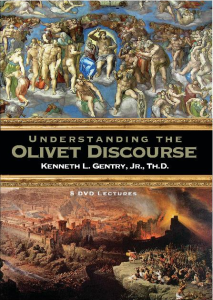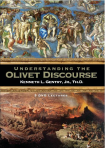UNDERSTANDING THE OLIVET DISCOURSE
PMW 2022-058 by Kenneth L. Gentry, Jr.

On this site, my most popular postings deal with either the Book of Revelation or the Olivet Discourse. The main focus of my site is obviously the postmillennial hope and its affirmation of the glorious progress of the gospel to victory in history. However, the judgment issues emphasized in both Olivet and Revelation are necessary to understand if one is going to defend gospel victory.
I recently spoke at a conference where I gave five lectures on Matthew’s version of the Olivet Discourse. This was videotaped and is now in available as a DVD set titled “Understanding the Olivet Discourse.” The lectures were well received and the DVDs are doing well, for which I am thankful and encouraged.
The five lectures I presented covered all the major issues in Matthew 24–25, providing a helpful study on this noteworthy teaching by Christ. In the present article I will provide a brief introduction to the lectures, hoping to whet your appetite. This DVD set should be a helpful means for presenting the orthodox preterist view of the Lord’s great discourse. I highly recommend your buying it for that purpose — as does my wife, two of my three children, and two of my six grandchildren (the others were in bed asleep when I asked them if they would recommend viewing the lectures, due to elementary school starting the next day).
The five lectures were:
The Apostle’s Anticipation of the Olivet DiscourseThe Disciples’ Expectation in the Olivet DiscourseThe Christian’s Questions about the Olivet DiscourseThe Lord’s Transition in the Olivet DiscourseThe Final Judgment’s Presentation in the Olivet DiscourseThe Apostle’s Anticipation of the Olivet DiscourseThis opening message provides the necessary introduction to the Apostle Matthew’s version of Olivet, noting that it is unique in being Jesus’ only fully eschatological discourse. It also points out that it is the fullest of the three versions found in the Synoptic Gospels, covering two full chapters (Matt. 24–25). This should provide us with incentive to carefully study it for a fuller understanding of Olivet.
_____________________________________________________________________________

Understanding the Olivet Discourse (DVD set) by Ken Gentry
This five-lecture set presents all the essential elements necessary for properly understanding the Olivet Discourse. It shows that the Discourse opens with prophecies regarding the AD 70 destruction of the temple, but then concludes with the Final Judgment to which AD 70 points.
For more educational materials see: www.KennethGentry.com
_____________________________________________________________________________
Thus, to better understand the Discourse, I highlight its setting in Matthew. I point out that the Apostle develops the growing Jewish antipathy to Jesus and the developing Gentile reception of him. It opens with the Jews fearful upon hearing of Christ’s birth (Matt. 24:3), while the Gentiles come to see him (Matt. 2:1–2). It closes with Jesus ending his special focus on Israel (cf. 10:5–6; 15:24), while opening his mission to “all nations” (Matt. 28:19–20). Thus, as Jesus’ final major Discourse of five in Matthew, Olivet becomes the capstone to Jewish resistance and Gentile acceptance. Matthew’s well-crafted Gospel builds toward Olivet in a impressive, instructive, and important way.
The Disciples’ Expectation in the Olivet DiscourseTurning from the Apostle Matthew’s anticipating Olivet in the structuring of his Gospel, I then proceeded to highlight how the Disciples received this surprising Discourse. In this lecture I strongly emphasize the exegetical evidence that the great tribulation is past, having occurred in the events leading up to and including AD 70. This affirmation oftentimes spins people’s toupees around when they first hear it. But the conferees knew what I was going to be presenting. So they took it well, with very few of them crying out: “Heretic! What have we got to look forward to if the great tribulation judgment is over!” Or: “Away with him! We have no interpreter but Lindsey!” Nor did they burst out in song, singing: “My hope is built on nothing less that Scofield’s notes and Moody Press.”
My first point in this message was to stress that the tribulation was historically limited, i.e., to the first century. That is, it was limited to “this generation” to which Jesus spoke (Matt. 24:34). Thus, it was extremely relevant to his original audience, which lived in a dramatically important period of redemptive-history.
Furthermore, the tribulation was focused on the area around Jerusalem and Judea (Matt. 24:16). It was not a worldwide judgment, though AD 70 was a harbinger of that ultimate judgment, the Final Judgment at the end of history. Like the several Old Testament “day of the Lord” events, it was important in itself, but ultimately pointed beyond itself to a fuller reality.
The Christian’s Questions about the Olivet DiscourseIn this message I focused on the modern Christians’ confusion regarding the historical fulfillment of the Discourse. I survey the leading verses that confound them, explaining them in terms of both the local context in Matthew, as well as the broader context of all of Scripture.
Olivet Discourse Made Easy (by Ken Gentry)
Verse-by-verse analysis of Christ’s teaching on Jerusalem’s destruction in Matt 24. Shows the great tribulation is past, having occurred in AD 70, and is distinct from the Second Advent at the end of history.
See more study materials at: www.KennethGentry.com
Oftentimes modern believers cannot initially accept the fact that the great tribulation was the worst ever (Matt. 24:21). They cannot do so because they do not understand what Jesus’ prophetic parlance and the enormity of the destruction of the temple. Nor can they understand “the abomination of desolation” in the broader setting of Scripture (v. 15).
Furthermore, they see Matthew 24:27 as devastating impediment to the past-tense fulfillment of Olivet. For they do not properly understand the structure and flow of the Discourse. This confuses them regarding this reference to Christ’s coming “as lightning.” This coming is a warning that when Christ returns again at the end of history it will be a very clear and dramatic event. Whereas in the first century great tribulation people would be spreading rumors that he is hiding in a room or in the wilderness (vv. 23, 26). Thus, Jesus mentions the nature of his Second Coming to warn that it will not be something that could be hidden.
Other issues tripping up the contemporary Christian include his coming on the clouds (Matt. 24:29), his gathering his elect (v. 31), and so forth. These can all be easily explained in terms of his first-century judgment of Jerusalem. If you don’t believe me, buy the DVD set and you will see. And I recommend you buying two copies of the DVD set just to see if I am consistent (if this marketing ploy works I will be well set, able to engage in
Other issues tripping up the contemporary Christian include his coming on the clouds (Matt. 24:29), his gathering his elect (v. 31), and so forth. These can all be easily explained in terms of his first-century judgment of Jerusalem. If you don’t believe me, buy the DVD set and you will see. And I recommend you buying two copies of the DVD set just to see if I am consistent (if this marketing ploy works I will be well set, able to engage in “a little sleep, a little slumber, a little folding of the hands to rest”).
The Lord’s Transition in the Olivet DiscourseIn my fourth study I focused on the hotly debated issue of the transition in the Discourse from the first century events to the last century events. That is, the shifting from the AD 70 metaphorical judgment-coming of Christ to the last century literal judgment-coming of Christ to which AD 70 points.
I began this message by carefully analyzing the Disciples’ confused questions in Matthew 24:2. I show how these two questions fuse together in their minds the destruction of the temple with the Second Coming / Final Judgment. This will require that the Lord break them apart. They deemed Christ’s denunciation of the temple (v. 1) as inscrutable without the Second Coming. But in his Discourse he will unscrew the inscrutable.
I show how the Disciples’ are frequently confused at Jesus’ teaching, requiring him to straighten them out. And that is what he does in the way he treats their two questions sparking the Discourse. He warns that some will mislead them (Matt. 24:4), but that they should not allow themselves to be misled — by properly understanding what he will teach them.
The Lord draws a distinction between the first century temple judgment and the last century final judgment, beginning in Matthew 24:34–36. After this transition passage (properly understood) he will then deal with the Second Coming as a distinct and distant future event whose time is unknowable, even to Jesus himself (v. 36). Whereas the coming of the temple’s destruction was known to be in their lifetimes (v. 34). I provide thirteen reasons that there must be a transition from the first century judgment on the temple to the last century judgment on the world. Jesus is not simply a Jewish sage concerned only with Israel; rather he is the Lord of all nations, who themselves must be judged as well.
The Final Judgment’s Presentation in the Olivet DiscourseHaving demonstrated that Jesus distinguishes two events in the Disciples’ double-question and that he establishes a transition in the midst of his Discourse, I then proceeded to explain Matthew 24:37–25:46. As I surveyed these verses I showed how they fundamentally differ from the preceding verses dealing with AD 70. I also set the teaching in this section in the larger scope of Christ’s relation to the nations.
Conclusion
I am working on a major commentary on Matthew 21–25, whereby I hope to more fully explain the Olivet Discourse from an orthodox preterist perspective. But the two chapters containing the actual Discourse are fundamental to understanding Jesus’ eschatology. I hope you will review these lectures and learn how to defend the preterist viewpoint without slipping into the hyperpreterist nuisance and while extricating yourself from the dispensational nonsense.
Kenneth L. Gentry Jr.'s Blog
- Kenneth L. Gentry Jr.'s profile
- 85 followers



